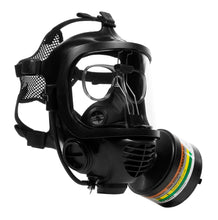


#CHANGING GAS MASK FILTERS SKIN#
The clean water rinse removes excess detergent or disinfectant that can cause skin irritation or dermatitis. Rinse with clean water, or rinse once with a disinfectant and once with clean water.Wash with a mild dish detergent or a combination of detergent and disinfectant.Follow the manufacturer's instructions.Ensure that the batteries are fully charged before using them.If this is not done regularly, the NiCad batteries may not provide power for as long as the specifications state. Before recharging nickel-cadmium (NiCad) batteries, fully discharge them with a discharger designed for those batteries.Follow the manufacturer's instructions for charging/discharging.Ensure that protective screens are intact and fit correctly over facepiece (abrasive blasting hoods and blouses).Check seams in suit or blouse for rips and tears.Monitor the operation of air-purifying elements and carbon monoxide or high-temperature alarms.Ensure the proper operation and condition of all regulators, valves or other airflow device.Inspect the air-supply hose and end-fitting attachments for breaks, cracks, or kinks.Check the end of service life indicator for gas masks.Check the filter housing for cracks or dents.Inspect both the filter threads and facepiece threads for wear, make sure they are screwed together properly, and there is no cross threading.Check the filter to see that they are approved for the hazard.Ensure that the filter and mask are certified for use together.Replace any missing or defective valve covers.

#CHANGING GAS MASK FILTERS FREE#

#CHANGING GAS MASK FILTERS FULL#
For a full facepiece respirator, check for missing mounting clips.Make sure the facepiece edges are not rippled or distorted.Ensure that the metal nose clip forms easily over the bridge of the nose on disposable respirators.Inspect for cracked, scratched or loose-fitting lenses and missing gaskets.Ensure that no holes or tears are present.Follow the manufacturer's instructions and consult CSA Standard Z94.4-11 (R2016) Selection, Use and Care of Respirators, for information on the care, maintenance, and storage of respirators.Replace all parts that are cracked, torn, broken, missing or worn.Inspect equipment designated for "emergency use" at least monthly, and before and after each use.Inspect the respirator before and after each use and during cleaning.What is an example of a checklist for caring for my respirator? Back to top Checklist for care of respirators You are here: Respirators - Respirator Care


 0 kommentar(er)
0 kommentar(er)
